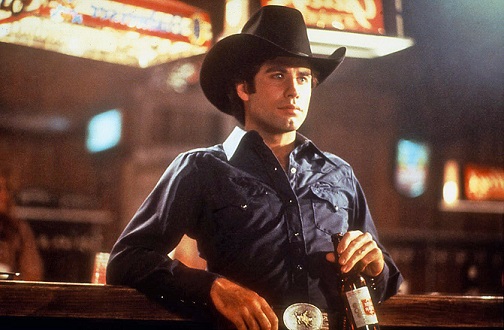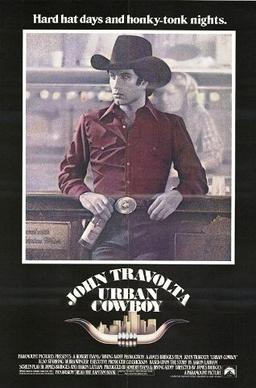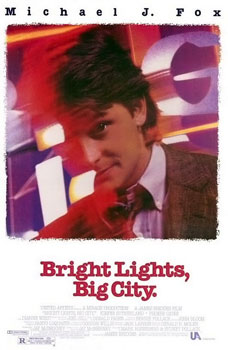Last night, I watched the 1980 film, Urban Cowboy. This was a film that had been sitting on my DVR for over a year. For some reason, I had never actually gotten around to watching it. There were many times when I started to watch it but I always ended up stopping after a few minutes. I was never quite sure why as everything that I had heard about the film was positive. Having finally watched it last night, I think I hesitated because I instinctively knew that John Travolta would look silly wearing a cowboy hat.
And let’s just be honest. He does. I mean, Travolta actually gives a fairly good performance in Urban Cowboy. He plays Bud, a kid from West Texas who moves to Houston so that he can work on an oil rig with his uncle, Bob (Barry Corbin). At first, he only wants to stay in Houston long enough to raise the money to buy some land back home. But, he soon falls in love with the Houston nightlife and the local country-western bar. (He’s Travolta so, of course, he can dance.) He also falls in love with and eventually marries Sissy (Debra Winger).
Travolta is believable as an impulsive young adult who might not be particularly smart but who makes up for it with a lot of determination. And he even does an okay job when it comes to capturing the country accent of West Texas. But that said, whenever he puts on that cowboy hat, the viewer is immediately reminded that Travolta is actually from New Jersey and probably never even attended a rodeo until he was cast in Urban Cowboy. The hat feels like an affectation, an attempt by a city boy to be more country as opposed to a country boy trying to hold onto his identity in the city. Ironically, the term “urban cowboy” has come to mean someone who, despite having never left the city, dresses like they’re heading out to herd the cattle and rope some steers. However, in the film itself, the hat is meant to be a natural part of Bud’s persona but it never quite feels that way.
Far more credible as a cowboy is a youngish Scott Glenn, who plays Wes Hightower. After Bud’s chauvinistic and abusive behavior drives Sissy away, she ends up with Wes. Wes teaches Sissy how to ride a mechanical bull, which is something Bud tried to forbid her from doing. Wes is confident and dangerously sexy and he can even make the fact that he lives in a run-down trailer work for him. Unfortunately, Wes also turns out to be even more controlling and abusive than Bud. Even though Bud still loves Sissy and Sissy still loves him, Bud soon hooks up with Pam (Madolyn Smith), the daughter of a wealthy oilman.
Many more complications follow and, of course, there’s one big tragedy that causes Bud to reexamine his life. Not surprisingly, the film’s conclusion all comes down to who can stay on that mechanical bull for the longest….
The best thing that Urban Cowboy has going for it is not Travolta or Glenn but instead, it’s Debra Winger, who gives a believable and relatable performance as Sissy, playing her as someone who may not have much but who refuses to surrender her pride. She knows that she deserves better than both Bud and Wes, even if she is hopelessly in love with one of them. Winger has chemistry with both Travolta and Scott Glenn, which makes the film’s love triangle feel like something more than just a typical story about a girl who can’t resist a bad boy. She grounds the film in reality and, as such, there are real stakes to the film’s story. Thanks to Winger, Urban Cowboy becomes about something more than just a fight over a mechanical bull.
The second best thing that Urban Cowboy has going for it is that it does manage to capture the atmosphere of a good country-and-western bar. It’s place where people go to relax after a hard day’s work. Unlike the discotheques that Travolta frequented in Saturday Night Fever, the bars in Urban Cowboy eschew glamour and artifice. Instead, they’re all about proving yourself not on the dance floor but on the back of a mechanical bull. For Sissy, the bull symbolizes freedom. For men like Bud and Wes, it symbolizes survival. Myself, I’m not a drinker so my bar experience is limited. And, though I may be from Texas and I spent a lot of time in the country while I was growing up, I’ve never been a fan of country music. That said, I’ve danced to a few country songs and I’ve certainly stopped by a few bars, even if I was usually the one who annoyed my family and friends by just asking for a glass of water. I’ve been to the rodeo and I’ve seen people get trampled. I’ve also seen a few people get tossed off a mechanical bull. I’ve never been on a mechanical bull myself but I did buy one for my Sims. (They loved it but, sadly, I had to get rid of it because they spent so much time riding it, they kept missing work and getting fired.) From my limited experience, I can say that Urban Cowboy got most of the details right. Even though it was made 42 years ago, it still feels authentic.
That said, Travolta still looks odd wearing a cowboy hat.



